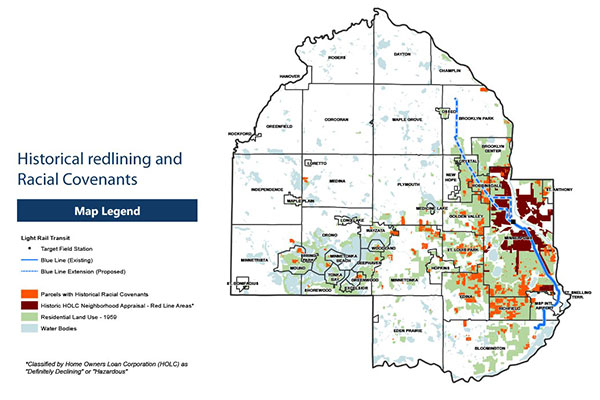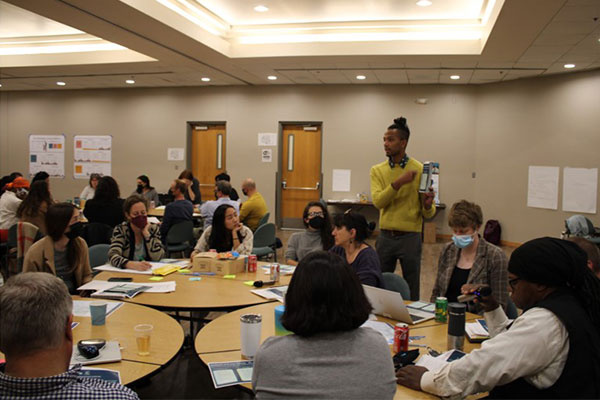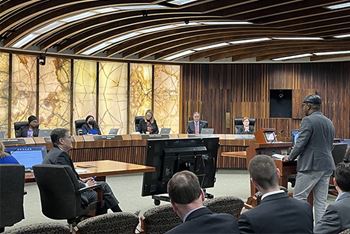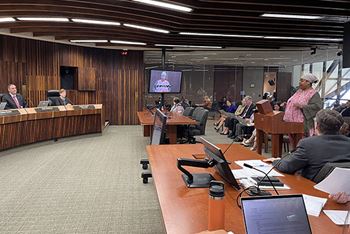Preventing displacement, helping communities thrive along the Blue Line Extension
This is the first transit project recognized by the Federal Transit Administration that embeds anti-displacement work.
The Blue Line Extension project has the potential to connect people and bring significant investments and development opportunities to communities along the line. This line will serve areas of Hennepin County that have experienced historic disinvestment, and continue to live with the impacts of redlining, racist property covenants, and other effects of systemic racism.
The investments that come with a project of this size also brings concerns of displacement for vulnerable populations. The county has a responsibility to ensure these patterns are not exacerbated by this project. In response, project partners are working with community to create a plan for the light rail line that implements strategies and policies that prevent displacement and support people in the corridor today.

A map of historical redlining surrounding the existing Blue Line and proposed extension.
Working with community to prevent displacement
When Hennepin County and the Metropolitan Council announced the need to find a new route for the Blue Line Extension in 2020, robust engagement efforts started to find new options that served communities.

A proposed Blue Line extension route
The Blue Line Extension project has:
- hosted and partnered on 415 events with more than 17,000 points of contact.
- reached more than 85,000 people on social media and over a million through paid advertising in community and cultural media.
- collected more than 4,100 survey responses and 1,700 comments on our interactive project map.
Project staff are regularly talking with business and meeting with residents. To ensure many different voices are heard, the county contracted with 15 community partners and is working with several youth-focused organizations to bring young voices to the table. The county is also working with local artists to engage people in surprising and joyful ways. In 2022, more than 5,000 residents engaged with the project through art and artist-led events.
Now is the time to prevent displacement
Displacement begins not with construction or the opening of the line, but with the official selection of the route. The project is currently working toward that milestone, and by advancing this work early in the project planning process, the county can not only prevent displacement, but maximize the value and benefits this transit investment will bring to communities along the route.
Developing community recommendations with CURA
The county contracted with the University of Minnesota’s Center for Urban and Regional Affairs (CURA) to lead anti-displacement research and in-depth community-engagement with the goal of developing a set of recommended outcomes and strategies for project partners to consider and advance.
CURA convened a diverse workgroup of public, private, community and philanthropic partners to better understand the risks of displacement and think creatively about how to prevent it. The 27-member workgroup worked over 18 months. The meetings were data driven and centered on research provided by CURA, and collectively, the participants worked to build a more transparent discussion amongst the various stakeholders in the project.

An anti-displacement workgroup meeting.
Jackson George a workgroup participant and Executive Director of the Liberian Business Association (LIBA) shared his experiences with the Hennepin County Board of Commissioners. “Over the period of time we've been part of the process… we worked through most of our fears of gentrification, of being displaced,” George said. “One of the things that I like about the process is that it is engaging. They didn't come to us like ‘we’re going to build this train … and this is how it's going to be.’”
Candy Baikon, a workgroup participant and North Minneapolis resident agreed, “I really felt that my opinions mattered, and that I was listened to.”
“These recommendations are relevant to each of these groups. That's not all for Hennepin County to implement, it’s not all for the Metropolitan Council to implement. And I surely envision that philanthropy and community organizations will be a big part of achieving this light rail extension dream, including anti-displacement,” said CURA’s Director of Community-based Research, C. Terrance Anderson.


George Jackson (left) and Candy Baikon (right) share their experiences in the anti-displacement workgroup with the Hennepin County Board of Commissioners.
Moving forward, taking action
The county is already in the process of scoping and planning for the next steps.
The recommendations have been shared with the project’s business and community advisory committee and the Blue Line Extension Corridor Management Committee. Work will begin with these partners to develop an implementation plan. It is important to plan for what is needed before, during, and after construction, so the project has the right strategies and resources in place when they are needed.
“We need to recognize that in many ways, preventing displacement is the bare minimum,” says Hennepin County Senior Administrator of Transit and Mobility, Cathy Gold “It’s not enough to just make sure this project doesn’t displace those it’s intended to serve. We need to go further. We need to make sure we fully leverage this once-in-a-generation opportunity to drive transformational investment that advances community’s vision for the future.”
The county is also looking for feedback from the broader community. Anyone can read and review the recommendations and provide feedback at Your Blue Line Extension - Anti-displacement.
This story reflects Hennepin County disparity reduction priorities in Transportation, Education, Employment, Health, Housing, Income, and Justice.
